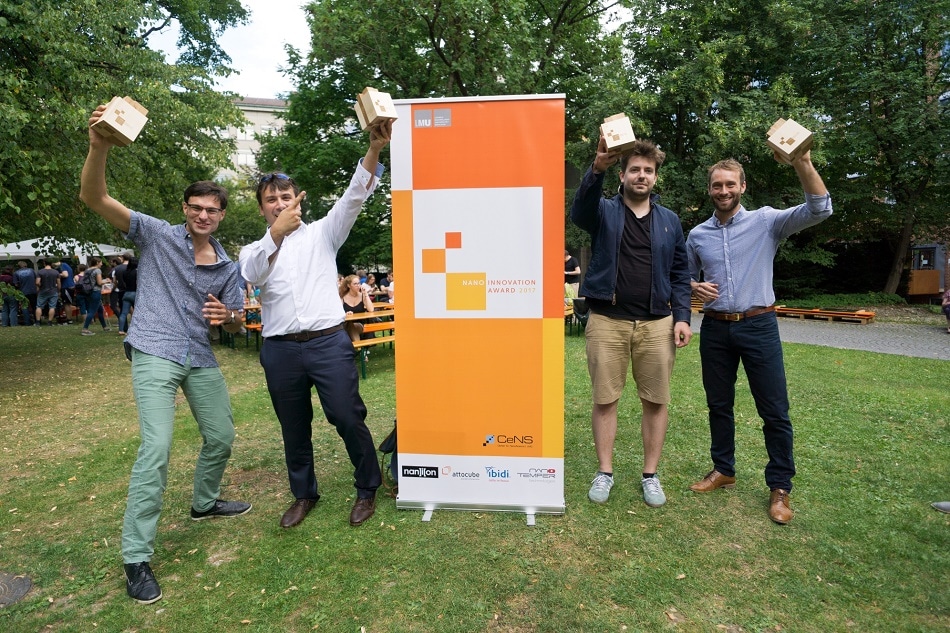
Image Credits: Attocube Systems
On July 21, the Nano Innovation Awards were awarded at the Center for Nanoscience (LMU Munich). For the first time, candidates from all over Bavaria were invited to apply for the awards worth € 9.000. Three PhD students and one Master student from Würzburg and Munich won prizes for their innovative work in application-oriented nanoscience. Since many years, attocube is one of the sponsors of the Award.
While most scientific prices emphasize on findings and results in fundamental research only, the Nano Innovation Award decidedly attaches importance to future applicability. The prize money is donated by four successful spin-offs of CeNS, all with their own company history directly connected to the idea of the award. The companies attocube systems AG, ibidi GmbH, Nanion Technologies GmbH und NanoTemper Technologies GmbH together with CeNS honor gifted and creative junior researchers, whose results are not only interesting for fundamental research but also promising for technological applications.
Florian Schüder from the group of Professor Ralf Jungmann (MPI of Biochemistry/LMU München) received an award worth € 3.000 in the category "Master's thesis": Super-resolution techniques are starting to revolutionize biology by enabling researchers to observe structures inside cells with unprecedented spatial resolution, beating the classical diffraction limit by more than an order of magnitude. However, most techniques are restricted due to technical reasons to structures that are very close to the cover glass, thus preventing whole-cell or tissue imaging with standard instrumentation. In his master’s thesis research, Florian Schüder implemented the recently developed DNA-PAINT super-resolution technique using a minimally modified spinning-disk confocal microscope to extend imaging to whole cells and potentially tissues. Due to the wide availability of spinning-disk microscopes in standard biology labs and imaging facilities, researchers can now answer questions with super-resolution in whole cells and beyond.
In the category "PhD thesis", the jury split the prize worth 6.000 EUR among three awardees: Magnetic Particle Imaging (MPI) is a new tomographic imaging method for the 3D-detection of superparamagnetic iron-oxide nanoparticles (SPIONs). In the thesis work of Dr. Patrick Vogel (group of Professor Peter Jakob, Julius-Maximilians-Universität Würzburg) a novel scanner concept, the traveling wave MPI (TWMPI) system, was developed and built, which allows the rapid and highly sensitive visualization of SPIONs. TWMPI is a promising non-invasive imaging modality that could already prove its high potential for medicine, biology and geology in preliminary experiments.
For more than 60 years cytostatic agents have been used in chemotherapy against cancer but featuring no selectivity exclusively for cancer cells. Most of those cytostatics also affect the healthy tissue of the human body causing sustainable harm and severe side effects. The thesis of the chemist Stefan Datz (group of Professor Thomas Bein, LMU München) focused on the synthesis and modification of nanomaterials for drug delivery applications to specifically target cancerous tissue without harming healthy tissue. The requirements for efficient stimuliresponsive and thus controllable release of cargo molecules into cancer cells and the design principles for smart and autonomous nanocarriers are discussed.
Personalized medicine is going to be the main achievement of patient care. Under the motto "One patient, one tumor profile, one personalized treatment", a novel micropatterning technique was developed in the scope of Dr. Peter Röttgermann’s PhD thesis (group of Professor Joachim Rädler, LMU München). These micropatterns allow to screen thousands of single cells in parallel for different cell death marker in a time-resolved way. The analysis of these heterogeneous multi-color signals allows for identification of the right compound of drugs for a successful, personalized tumor treatment.